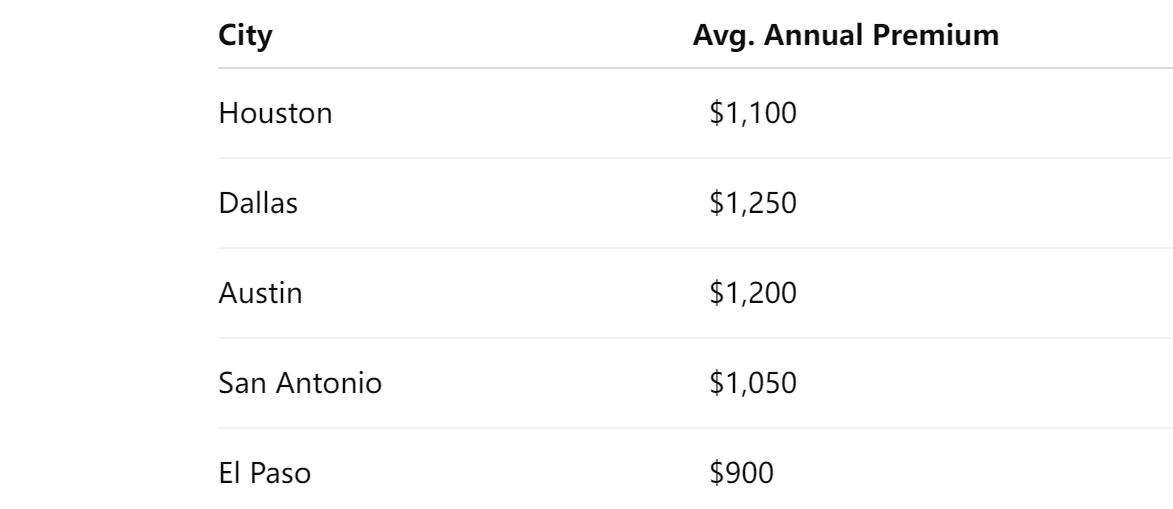Texas Home Insurance Guide 2025: Shield Your Lone Star Home and Budget
Published on July 17, 2025
🏠 Texas Home Insurance Guide 2025: Shield Your Lone Star Home and Budget
Introduction
In Texas, your home faces coastal hurricanes, North Texas hailstorms, Central Texas wildfires, and Gulf Coast floods. Securing the right homeowners insurance in Texas protects your property and finances when severe weather and accidents strike.
This guide helps you choose between HO-3 and HO-5 policies, compare average home insurance premiums by major cities, and implement proven strategies to secure cheap homeowners insurance in Texas without sacrificing essential coverage.
1. Tailoring Coverage: HO-3 vs. HO-5 Policies
HO-3 (Special Form)
- Named-peril coverage: Protects your dwelling against specified risks like fire, windstorm, hail, and theft
- Named-peril personal property: Insures belongings for listed perils
- Cost-efficient: Ideal for homes in moderate-risk areas with standard rebuild costs
HO-5 (Comprehensive Form)
- Open-peril coverage: Safeguards home and personal property against all risks except those explicitly excluded
- Enhanced property limits: Better for high-value homes and belongings
- Premium considerations: 20–30% higher than HO-3 but reduces out-of-pocket expenses on claims
Recommendation: Select HO-5 if your home's replacement cost exceeds $400,000, or if you own valuable personal property; otherwise, HO-3 is typically sufficient.
2. City Premium Comparison: Houston, Dallas & Austin
Your location directly impacts your Texas home insurance premium. For a 2,000 sq ft home with $300,000 dwelling coverage in 2025:

- Dallas sees higher rates due to frequent hail and windstorm claims.
- El Paso enjoys lower premiums thanks to a dry climate and fewer natural hazards.
Use ZIP-based rate checks to compare Texas home insurance quotes and find localized savings.
3. Core Coverage Essentials
A comprehensive policy should include:
- Dwelling Coverage: Rebuilds or repairs your home after covered disasters
- Personal Property: Reimburses you for damaged or stolen belongings
- Liability Protection: Covers legal fees and medical costs if someone is injured on your property
- Additional Living Expenses (ALE): Pays for temporary housing if your home becomes uninhabitable
Tip: Adjust your Replacement Cost Value (RCV) annually to account for rising labor and material costs in your area.
4. Four Proven Cost-Saving Strategies
- Reinforce Risk Mitigation: Install hail-resistant roofing, hurricane straps, and fire-resistant landscaping to qualify for up to 20% discounts.
- Bundle Policies: Combine your home and auto insurance with one provider to unlock multi-policy savings (10–25%).
- Raise Your Deductible: Opt for a $2,000–$5,000 deductible if you have emergency funds—this can reduce premiums by 15–20%.
- Maintain a Clean Claims Record: Cover minor repairs out-of-pocket to preserve your claims-free discount and avoid rate hikes.
Implementing these strategies can significantly lower your Texas homeowners insurance costs year over year.
5. Must-Have Endorsements for Texas Risks
Standard policies often omit critical perils—consider adding:
- Windstorm/Hail Coverage: Essential for North and Central Texas to cover hail damage.
- Flood Insurance: Purchase through the National Flood Insurance Program (NFIP) or private carriers for Gulf Coast and river areas.
- Wildfire Protection: Endorsements for homes near brush or rural regions.
- Equipment Breakdown: Covers HVAC, electrical, and plumbing system failures during storms.
These add-ons transform standard coverage into robust full coverage homeowners insurance in Texas.
6. Top-Rated Providers in 2025
Evaluate these carriers for their Texas expertise and competitive offerings:
- State Farm: Extensive agent network, bundling perks, and reliable claims handling.
- Allstate: Digital tools, add-on packages, and flexible coverage options.
- Texas Farm Bureau: Local insights, farm & ranch endorsements, and member discounts.
- USAA: Exceptional service and rates for military personnel and families.
- Farmers Insurance: Customizable endorsements for hail, windstorm, and wildfire risks.
Compare customer satisfaction scores and financial strength ratings to select the best homeowners insurance provider in Texas for your needs.
Conclusion
Securing the right homeowners insurance in Texas requires balancing affordability with comprehensive protection against hail, floods, and wildfires. By comparing HO-3 vs. HO-5 forms, analyzing city premium variations, and implementing targeted savings tactics, you’ll safeguard your Lone Star home and finances in 2025.